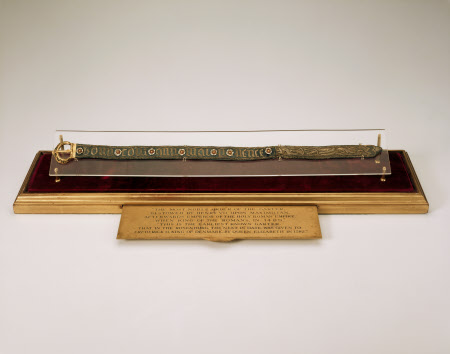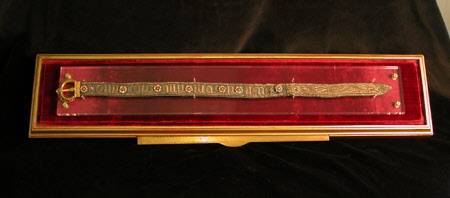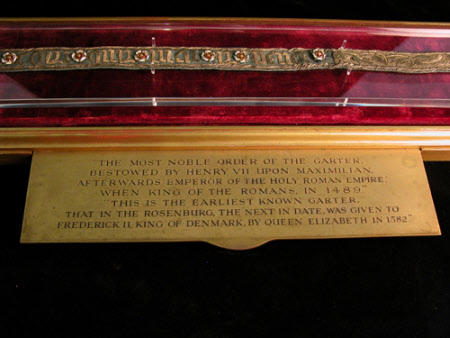The Emperor Maximilian's Garter
Category
Gold
Date
1489
Materials
Gold, Textile, Enamel and Silver
Measurements
55 x 655 x 155 mm; 530 mm (Length - garter); 40 mm (Width - buckle); 22 mm (Width - ribbon)
Order this imageCollection
Anglesey Abbey, Cambridgeshire
NT 515303
Caption
Before the invention of elastic, garters or garter belts were needed to keep hose in place. They were fastened with a buckle below the knee, where the hose could otherwise become baggy. Edward III (1312–77) used the garter as a symbol of his new order of knights, the Order of the Garter, which still exists today. Roisin Semple The story goes that Edward chose it as his symbol to counter an embarrassing incident, when a lady’s garter fell down while she was dancing at a ball. The garter is worn below the left knee, to symbolise the binding together of members of the order in support of the English Crown. Given to Emperor Maximilian I (1459–1519) when he was made a knight by Henry VII (1457– 1509) in 1489, this example is the earliest known surviving garter of the order. The metalwork is original, but the textile is an accurate replica, probably made in the 1700s. The order’s motto is embroidered in silver-gilt thread: hony coyt quy mal y pence (‘shame be to him who thinks evil of it’).
Summary
Earliest known surviving garter of the Order of the Garter, given to Emperor Maximilian I (1459–1519) when he was made a knight by Henry VII (1457–1509) in 1489. The metalwork is original, but the textile is an accurate replica, probably made in the 18th century. The order’s motto is embroidered on blue silk in silver-gilt thread: 'hony coyt quy mal y pence' (‘shame be to him who thinks evil of it’). There are seven Tudor rose-shaped ‘stops’ between each word which are enamelled red upon white. It is presented in a gilt presentation case, lined with velvet with a modern replica acrylic lid. A pull-out metal panel reveals a provenance statement: 'The Most Noble Order of the Garter bestowed by Henry VII upon Maximilian, afterwards Emperor of the Holy Roman Empire, when King of the Romans in 1489./ This is the earliest known Garter, that in the Rosenburg, the next in date, was given to Frederick II, King of Denmark, by Queen Elizabeth in 1582.'
Full description
Edward III (1312–77) used the garter as a symbol of his new order of knights, the Order of the Garter, which still exists today. The story goes that Edward chose it as his symbol to counter an embarrassing incident, when a lady’s garter fell down while she was dancing at a ball. The garter is worn below the left knee, to symbolise the binding together of members of the order in support of the English Crown. Its design has not changed significantly since the founding of the order, although there have been many variants of the spelling of the order’s motto. The arms of Maximillian I as King of the Romans (elected king in 1486, emperor in 1493) are faintly discernible on the backplate of the buckle. Maximillian was made a Stranger Knight by Henry VII in 1489. He was invested with the insignia in 1490, and again in 1503. When the King of Arms delivered the insignia in 1503, the king instructed him to observe how it was accepted by Maximillian and how often he wore any Garter ornaments.
Provenance
The Counts Festetics, Hungary; entered the collection of Lord Fairhaven between 1918 and 1939. Part of the Fairhaven Collection. The house and contents were bequeathed to the National Trust by Huttleston Rogers Broughton, 1st Lord Fairhaven (1896-1966).
References
Antrobus and Slocombe 2025: Helen Antrobus and Emma Slocombe, 100 Things to Wear: Fashion from the collections of the National Trust, National Trust 2025, pp. 22-23 Gothic Art for England 1400 - 1547 (eds. Richard Marks and Paul Williamson), V&A, London, 2003, p. 81 Beard 1953: Charles R. Beard, ‘The Emperor Maximilian’s Garter in the Collection of Lord Fairhaven’, The Connoisseur (1 March, 1953), p. 108-109. Begent & Chesshyre 1999: P. J. Begent & H. Chesshyre (ed.), The Most Noble Order of the Garter: 650 Years, London, 1999, p. 157-161.


